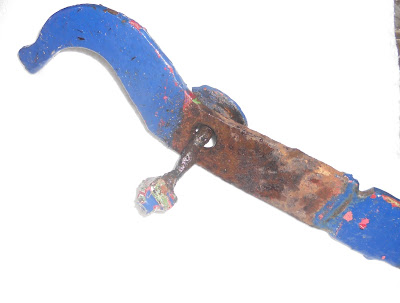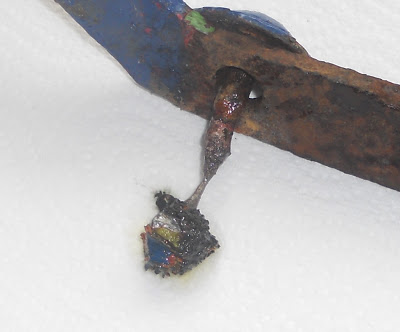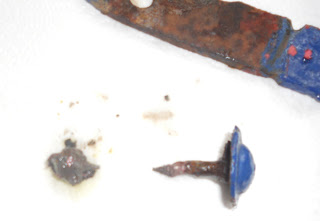Destroying a rusty bolt using electrolysis
Wednesday, 12 June 2013
Players of Nethack may occasionally encounter a "rust monster". This irritating creature does not do any physical damage, but contact with it causes metal items to rust. This diminishes their effectiveness, and can eventually cause them to disappear entirely. In the early stages of a Nethack game, a rust monster is one of many traps for the unwary. If you don't know the tactics to fight it, or you carelessly run into it, it will destroy your weapons and armour, and you will be left defenceless against other creatures.
Despite this, the rust monster does have some use: they're a last-resort way to destroy cursed items. Cursed weapons and armour can't be taken off, so players must either remove the curse or destroy the item. One way to destroy an item is to let it rust away, and a rust monster is helpful in this regard.
I found a real-life need for a rust monster while trying to repair the garden gate at the front of my house. This gate has a metal latch. The wood around the latch has rotted, and so I am replacing it with new wood. Unfortunately, the latch has also rusted. The bolt running through the latch cannot be undone. It is rusted solid:

This might force me to buy a new latch for the repaired gate. But what if I could remove the old bolt?
I thought about how to do this. The old bolt is plainly made from iron. Though rusty, it is still too strong to be destroyed with a hammer. I lack "bolt-cutters" or a saw that can cut through metal. Battery acid is a possibility - it will dissolve iron - but apart from buying car batteries, I do not know where to get it. And I do not want to ask, since my actual purpose is so bizarre that anyone I might ask is quite likely to report me to the police. These days, there are lists for people who give strange reasons for buying powerful chemicals.
So, what remains? What I would really like is to speed up the rusting process, sapping the strength of the bolt until it can simply be snapped. Oh, for a pet rust monster!
I came up with the idea of using electrolysis to dissolve the iron. This is possible without buying any specialist items - everything can be bought at the supermarket, if you don't already have it.
Electrolysis is the process where an electrical current is passed between two electrodes placed in a liquid. Depending on the liquid, and the material of the electrodes, the following things may happen:
- Gas may be given off at one or both electrodes,
- Metal may be deposited on one electrode ("electroplating"),
- A metal electrode may be destroyed.
The process is used to "plate" one metal onto another, so a low-cost metal can be given a protective or aesthetically-pleasing surface. In this case, what I want is the reverse of electroplating: I want to destroy an iron electrode.
I used a strong solution of salt water, using ordinary household salt. Into this, I placed a graphite cathode, and the iron bolt as the anode. The cathode was connected to the negative terminal of a 12V DC power supply. The anode was connected to the positive terminal. (By the way, you can get graphite electrodes from cheap zinc-carbon batteries.)
When switched on, gas bubbles appeared at the cathode. (Hydrogen: do this in a well-ventilated area.) The salt water turned rust-colour: first light brown, then dark brown, and finally a vile black. A disgusting sludge formed around the anode and in the solution. Someone with more than just A-level Chemistry would be better able to guess at the substances actually formed - but I think the sludge (and solution) is mostly iron oxide, commonly known as rust.
These were byproducts. At the same time, the anode was consumed by the process. It took all night, but the metal disappeared. The following day I removed the anode from the solution and washed it:

Notice the shiny pure metal. The outer layers of rust have all gone, removed by electrolysis, leaving only the actual metal. This shiny surface is much more conductive than the rust, so most of the electrical current flows here. This is a "virtuous circle": electrolysis happens most where I want it most, and the anode wastes away.
By the morning, so little metal remains that the bolt can be snapped in half using my hands. It's a success. I can now replace the bolt with a new one, while keeping the rest of the latch:
